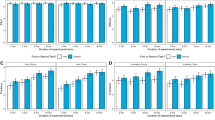Abstract
Self-regulation and self-control methods have been developed primarily in laboratory situations in which subjects are passive or engage in low-demand tasks. In clinical settings self-control techniques are often advocated for handling highly demanding situations. The present study examined the effects of self-regulatory processes on a primary task that requires focused attention and cognitive rehearsal. Ninety-four subjects in a 3(CPAT difficulty) ×3(type of secondary task) factorial design worked on a Continuous Paired Associate Task (CPAT). At regular intervals subjects were given either a selfregulatory task or simple math problems, or a 10-second delay was introduced. After 60 minutes, subjects could continue or quit. CPAT accuracy immediately following the secondary task or the delay decreased significantly in comparison to the preceding or subsequent intervals. Subjects who worked on the easiest CPAT or with the Delay interruption showed significantly smaller decrements in performance. Subjects who were given a self-regulation task completed the fewest trial blocks voluntarily. The detrimental effects of the secondary self-regulation task on a complex cognitive task suggest that the beneficial effects of self-regulatory techniques may be limited. They caution against their therapeutic use in stressful situations that require concurrent performance on a cognitively demanding task.
Similar content being viewed by others
References
Atkinson, R. C., Brelsford, J. W., & Shiffrin, R. M. (1967). Multiprocess models for memory with applications to a continuous presentation task.Journal of Mathematical Psychology, 4 277–300.
Avia, M. D., & Kanfer, F. H. (1980). Coping with aversive stimulation: The effects of training in a self-management context.Cognitive Therapy and Research, 4 73–81.
Carver, C. S., & Scheier, M. F. (Eds.). (1981).Attention and self-regulation: A control-theory approach to human behavior. New York: Springer-Verlag.
Condiotte, M. M., & Lichtenstein, E. (1981). Self-efficacy and relapse in smoking cessation programs.Journal of Consulting and Clinical Psychology, 49 648–658.
Deffenbacher, J. L., & Suinn, R. M. (1982). The self-control of anxiety. In P. Karoly & F. H. Kanfer (Eds.),Self-management and behavior change. New York: Pergamon Press.
Janis, I. L., & Mann, L. (1977).Decision making. New York: Free Press.
Kanfer, F. H. (1970). Self-regulation: Research, issues and speculations. In C. Neuringer, & K. L. Michael (Eds.),Behavior modification in clinical psychology. New York: Appleton-Century-Crofts.
Kanfer, F. H. (1977). The many faces of self-control, or behavior modification changes its focus. In R. B. Stuart (Ed.),Behavioral self-management. New York: Brunner/Mazel.
Kanfer, F. H., & Karoly, P. (1972). Self-control: A behavioristic excursion into the lion's den.Behavior Therapy, 3 398–416.
Karoly, P., & Kanfer, F. H. (Eds.). (1982).Self-management and behavior change. New York: Pergamon Press.
Kendall, P. C., & Hollon, S. D. (Eds.). (1979).Cognitive-behavioral interventions. New York: Academic Press.
Kirk, R. E. (1982).Experimental design: Procedures for the behavioral sciences (2nd ed.). Belmont, California: Brooks-Cole.
Kirschenbaum, D. S., & Karoly, P. (1977). When self-regulation fails: Tests of some preliminary hypotheses.Journal of Consulting and Clinical Psychology, 45 1116–1125.
Kirschenbaum, D. S., & Tomarken, A. J. (1982). On facing the generalization problem. In P. C. Kendall (Ed.),Advances in cognitive-behavioral research and therapy (Vol. 1). New York: Academic Press.
Lachman, R., Lachman, J. L., & Butterfield, E. C. (1979).Cognitive psychology and information processing: An introduction. Hillsdale, New Jersey: Erlbaum.
McFall, R. M., & Hammen, C. L. (1971). Motivation, structure and self-monitoring: Role of nonspecific factors in smoking reduction.Journal of Consulting and Clinical Psychology, 37 80–86.
Meichenbaum, D. (1977).Cognitive-behavior modification. New York: Plenum Press.
Meichenbaum, D., & Genest, M. (1980). Cognitive behavior modification: An integration of cognitive and behavioral methods. In F. H. Kanfer & A. P. Goldstein (Eds.),Helping people change (2nd ed.). New York: Pergamon Press.
Meichenbaum, D., & Goodman, J. (1971). Training impulsive children to talk to themselves: A means of developing self-control.Journal of Abnormal Psychology, 77 115–126.
Mischel, W., & Baker, N. (1975). Cognitive appraisals and transformations in delay behavior.Journal of Personality and Social Psychology, 31 254–261.
Mischel, W. Ebbesen, E. B., & Zeiss, A. M. (1972). Cognitive attentional mechanisms in delay of gratification.Journal of Personality and Social Psychology, 21 204–218.
Mischel, W., & Moore, B. (1980). The role of ideation in voluntary delay for symbolically presented rewards.Cognitive Therapy and Research, 4 211–221.
Novaco, R. W. (1979). The cognitive regulation of anger and stress. In P. C. Kendall & S. D. Hollon (Eds.),Cognitive-behavioral interventions. New York: Academic Press.
Shiffrin, R. M., Dumals, S. T., & Schneider, W. (1982). Characteristics of automation. In J. B. Long & A. D. Baddeley (Eds.),Attention and performance (Vol. 10). Hillsdale, New Jersey: Erlbaum.
Shiffrin, R. M., & Schneider, W. (1977). Controlled and automatic human information processing: II. Perceptual learning, automatic attending and a general theory.Psychological Review, 84 127–190.
Spates, C. R., & Kanfer, F. H. (1977). Self-monitoring, self-evaluation and self-reinforcement in children's learning: A test of a multi-stage self-regulation model.Behavior Therapy, 8 17–24.
Tomarken, A. J., & Kirschenbaum, D. S. (1982). Self-regulatory failure: Accentuate the positive?Journal of Personality and Social Psychology, 43 584–597.
Author information
Authors and Affiliations
Additional information
The authors would like to express their appreciation to Jonathan Higgins, Dawn lacobucci, Daniel Byars, John Figiel, Terri Menacker, Karen Ross, and Krystal Warden for their assistance in testing the subjects. The research was completed while the second author was a post-doctoral fellow at the University of Illinois. She is now at Purdue University.
Rights and permissions
About this article
Cite this article
Kanfer, F.H., Stevenson, M.K. The effects of self-regulation on concurrent cognitive processing. Cogn Ther Res 9, 667–684 (1985). https://doi.org/10.1007/BF01173025
Issue Date:
DOI: https://doi.org/10.1007/BF01173025




